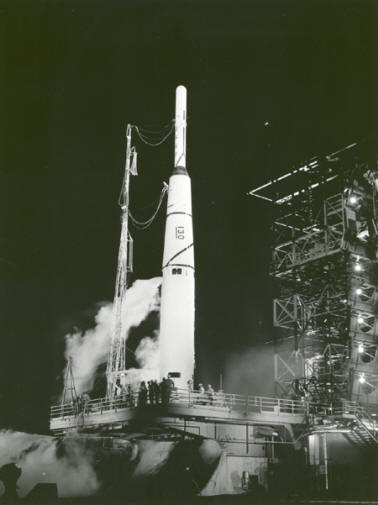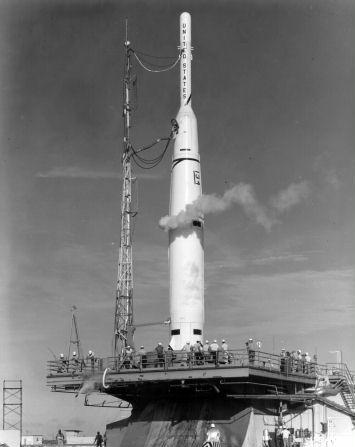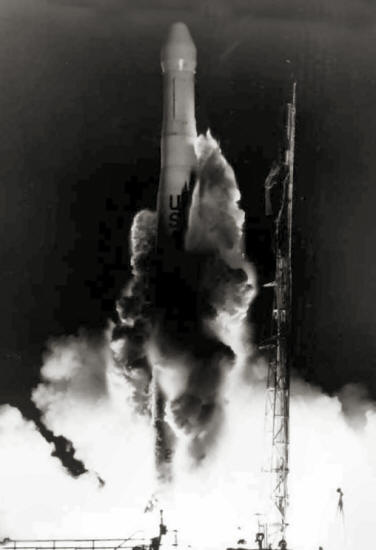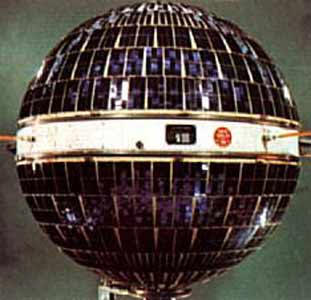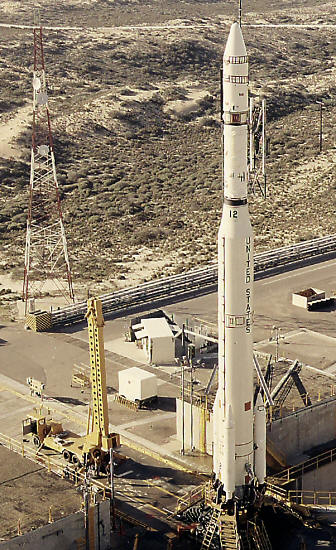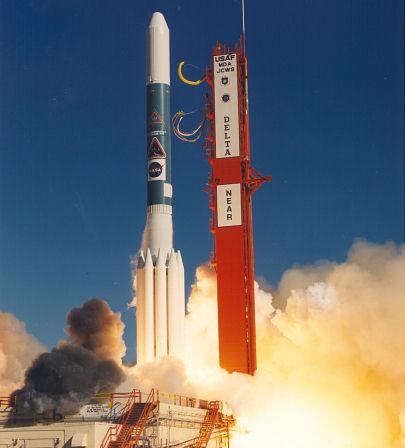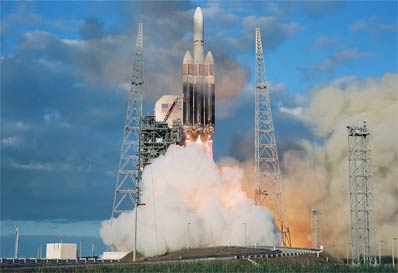The Rocket that Launched Telecom and an Irony of the Cold War
by Barry Davidoff and Tomas Kladiva
The Thor Able Star played a major role in the development of satellite communications. In 1960 it launched the world’s first active repeater communications satellite, Courier 1B. For 17 days Courier 1B received and transmitted radio messages between ground stations. Although very limited in its capabilities, this satellite heralded the advent of instantaneous communications almost everywhere on the planet.
One of the most important missions for the Thor Able Star, however, led to one of the most remarkable deceptions of the Cold War. On June 22. 1960 the rocket launched Solrad 1. On the surface, Solrad 1’s purpose was to study solar radiation. The launch was well reported and documented since in the early days of the space age not every launch was successful. It was not revealed until 1998 that Thor Able Star had carried America’s first reconnaissance satellite into orbit.
Thor Able I booster with Pioneer I spacecraft on launch pad
Photo: NASA
Development of Thor
The Thor rocket began development in 1954 by Douglas Aircraft as an IRBM (Intermediate Range Ballistic Missile), a weapon of the Cold War. It evolved into one of the most dependable launchers and its descendants, including the mighty Delta IV, still are being used widely today.
Thor was designed to carry a nuclear warhead 1500 miles (2400 km.), which is the distance from England and Moscow. The Thor rocket was only 65 feet long and 8 feet in diameter so that it could fit inside a C-124 Globemaster II cargo plane and flown to launch sites.
In order to speed development, the Thor incorporated existing components from other missiles. It engine came from the Navaho cruise missile and burned a mixture of liquid oxygen and kerosene to generate 150,000 pounds (66, 965 kg.) of thrust. The guidance system and its warhead were taken from the Atlas, which was being developed by Convair simultaneously.
The Thor was intended to be only a temporary measure in America’s arsenal while the longer range ICBM’s (Intercontinental Ballistic Missile) and submarine launched missiles were being developed. The first Thors were deployed to England at the end of 1958 and was withdrawn from service less than five years later.
Thor-Able – Thor first stage and Able upper stage. Able was derived from Vanguard.
Photo: NASA
The Thor was highly successful in testing and it was adapted into a satellite launcher by adding second and third stages and later strap-on boosters. The Thor was first mated with the second stage of the Vanguard rocket to become the Thor-Able. The Thor-Able was characterized by the long thin second stage. In October 1958, a Thor-Able launched Pioneer 1, the first attempt to send a probe to the moon. Although it failed to reach the moon and re-entered the next day, Pioneer 1 did return important scientific data.
Thor-Able Star
A larger payload shroud and improvements to the first and second stages of the Thor-Able formed the Thor-Able Star which could place a 220 pound (100 kg.) payload into earth orbit. The first stage was upgraded to produce 172,000 pounds (76,786 kg.) of thrust, which was an increase of 22,000 pounds (8861 kg.) of thrust. The second stage of the Thor-Able Star, which also was derived originally from Vanguard, featured the first re-startable rocket engine. It could be fired to correct the orbit of the payload. The second stage used nitric acid and UDMH (Unsymetrical Di-Methyl Hydrazine) as the propellants. It carried many notable satellites into orbit during its five year career in which there were 19 successful launches and five failures.
Thor-Able Star rocket #281, liftoff from Cape Canaveral June 22, 1960 with the first Solrad satellite onboard. Thor-Able Star had a re-startable second stage and larger payload shroud
Photo: NASA
Courier
The New Ware model presented elsewhere in this issue (see Modelling the Thor Able Star – Ed.) commemorates the Thor Able Star that launched the Courier 1B, since it played a pivotal role in developing modern satellite communications. This flight was one of the grandfathers of the modern telcom industry. Thor would evolve into Delta and would launch most of the communications satellites descended from Courier. This launch also represented the one hundredth launch of a Thor rocket. According to Tom Kladiva, “The rocket that launched the Courier 1B satellite was chosen since it among the best documented of the Thor Able-Star launches. Multiple photographs of the rocket provided accurate references for all the details and markings.”
Courier 1B
Courier 1B was an early communication satellite that was the first to receive and relay messages through transponders. Courier 1B was launched on October 4, 1960 and functioned for 17 days before it failed to respond to ground commands. It is far less well known than Echo 1, which had been launched that summer. Echo 1 was simply a 100 feet in diameter mylar balloon that bounced radio and television signals between ground stations. Echo 1 could be seen easily in the night sky and had been used in the first transatlantic television broadcast.
Whereas, Echo 1 was a passive satellite that reflected signals. Courier 1B received the signal and then amplified it before re-transmitting it to another ground station. Courier had been built by Philco, which was then part of the Ford Motor Company. To provide power, it was covered with 19,000 solar cells and was the first satellite to use nickel cadmium storage batteries. Courier 1B could transmit information at the rate of only 3.5 bytes/sec. which was too slow for television.
Solrad
The Thor-Able Star launch of Solrad 1 was a major milestone and one of the great ironies of the Cold War. Solrad was launched on June 22, 1960 together with the Transit 2A satellite, it was the first tandem launch of two satellites by the same rocket. The mission of both satellites was far different from thier announced purposes.
When launched, Transit 2A’s goal was stated to return geodesic data about the earth’s surface. When declassified in 1967 it was revealed that Transit 2 was part of the first series of military navigational satellites to provide the exact locations of ballistic missile submarines and their targets. Transit later led to the entire field of Global Positioning Systems which now allow drivers to find their way on roads with greater precision than the military originally used for launching missiles.
An even greater great irony of Thor-Able Star’s mission was Transit’s companion Solrad 1. The June launch of Solrad 1 was widely publicized and its name stood for SOLar RADiation Satellite. The satellite also was called GRAB-1, an acronym for Galactic Radiation And Background satellite. Solrad’s ostensible purpose was to provide information about the sun’s ultra-violet and x-ray output.
Solrad 1 (on top) being tested together with Transit 2A, which was to accompany it on the same launch.
Solrad weighed only 19 kg. and was powered by 936 solar cells which constantly recharged six nickel cadmium batteries. Aboard the satellite were two ionization chambers used to measure solar radiation and an x-ray spectrometer. Solrad was 20 inches (51 cm.) in diameter with the solar cells arranged in six circles with 6 inch (15 cm.) diameters.
Solrad was designed and developed by the Naval Research Laboratory under the direction of Dr. Herbert Friedman and Peter Wilhelm. It was reported at the time that Solrad was successful in providing information about solar and background information. It was followed by the unsuccessful launch of Solrad-2 in November 1960 and the launch of Solrad-3 which orbited in June 1961.
The Naval Research Laboratory constructed a replica of Solrad-3 from spare components and donated it in 1975 to the newly constructed Smithsonian Air & Space Museum. This replica of Solrad-3 was displayed for full public view in he Smithsonian. Millions of visitors passed under the while it was being displayed at the most visited museum in the world. Almost none of the millions of visitors knew Solrad’s true purpose.
Finally in 1998, after the end of Cold War and collapse of the Soviet Union, the Navy de-classified Solrad’s mission. It was revealed that Solrad’s purpose was not to obtain data on solar radiation, but rather of radiation from a very specific terrestrial origin. Solrad’s real goal was to monitor Soviet air defense radar transmissions. In a play on words, worthy of John LeCarre, the satellite which also was called by its acronym, GRAB-1, “grabbed” pulses from Soviet radars. The information would later be transmitted when it passed over ground stations later in the same orbit or on other orbits.
Solrad has the honor of being the world’s first successful ELINT (ELectronic INTelligence) satellite. The information provided on Soviet radar systems was invaluable during the Cold War to the American military. Solrad also was the world’s first successful reconnaissance satellite.
The Discoverer series of satellites previously was attributed as being the first reconnaissance satellites that returned strategic data. Discoverer XIII was launched on August 10, 1960 by a Thor Agena A and was the first object recovered from space. Its capsule was recovered in the mid-Pacific after it re-entered the earth’s atmosphere on August 12. The capsule was designed to test the method of recovery and did not contain a camera. Once the method was proven, Discoverer XIV was launched just six days later carrying a sophisticated mapping camera. Over one-fifth of the Soviet Union was photographed by the satellite before the capsule was successfully recovered revealing many sites of military interest.
The Thor-Agena
Photo: NASA
During the eventful summer of 1960 tensions between the Soviet Union and the United States peaked over the shooting down of a U-2 reconnaissance plane. Solrad’s successful gathering of Soviet radar pulses while in orbit had preceded the Discoverer photographs by two months.
The display of Solrad at the Smithsonian can be viewed as a wry practical joke during the Cold War. By the time that it was displayed in 1975, its technology was primitive and obsolete. The Naval Research Laboratory was not revealing any secrets by displaying it at the Air & Space Museum. Presumably, the Soviet Union had also learned of the great secret of Solrad by the time that it was displayed. However, though millions of people had the opportunity to see Solrad, few knew of its secret reconnaissance mission.
Evolution of Thor and Delta
In 1959 NASA asked Douglas to develop a civilian version of Thor to launch satellites. Since it was the fourth version of Thor (after Thor, Thor-Able and Thor-Able Star) it was designated the Thor-Delta since Delta is the fourth letter of the Greek alphabet. The Thor Delta used the basic Thor rocket as the first stage, the second stage from Vanguard and a X-248 solid rocket motor for the third stage. The Thor-Delta launched Echo I, the 100 foot in diameter mylar balloon that was the first passive communications satellite.
To differentiate Thor-Delta from its military roots, the rocket became known as the Delta. The Delta series became the backbone of the American space program and launched more satellites than any other American rocket. In more than 300 launches, over a period of 45 years, it has had a 95% success rate.
The Delta series would gradually evolve and every component would be upgraded and improved. The first major improvement, Delta A, was an improvement in the first stage main engine. Delta B with a lengthened second stage and Delta C with a larger payload shroud quickly followed. Three strap-on Castor solid fuel boosters were added to the first stage Thor rocket to become Delta-D, which also was known as the Thrust Augmented Delta. Continued improvements to the basic Delta would increase its payload capacity by a factor of ten in a period of nine years.
Delta continued to grow in the seventies and eighties as every component was again improved. By 1990 Delta II was introduced which bore little resemblance to the original Delta. Delta II stands 130 feet tall, which is 38 feet taller than the original Delta. Delta II uses 9 improved Castor solid fuel strap-ons and can place a 4120 pound satellite into geosynchronous orbit, which is forty times the capacity of the original Delta.
Delta II with multiple solid rocket strap-ons surrounding liquid rocket core
Photo: NASA
In 1998, Delta II again doubled its capacity and can place 8400 pounds into geosynchronous orbit and renamed Delta III. The first stage of Delta III retained the same 8 foot diameter, but it is now powered by liquid oxygen and liquid hydrogen which have a higher specific impulse than the kerosene and liquid oxygen used in the preceding Deltas.
The latest version, Delta IV, bears resemblance to the original Delta in name only. The Delta IV comes in five variations that can launch from between 17,900 pounds (8,120 kg.) to 50,800 (23,040 kg.) into low earth orbits.
The Delta IV family is based on the Common Booster Core which is 16 feet in diameter and powered by a RS68 engine fueled by liquid hydrogen and oxygen that produce 650,000 pounds (2891kN.) of thrust The second stage is powered by a RL-10 engine and is produced in different lengths to increase the total power. The medium plus versions also use 2-4 solid fuel strap-on boosters.
The Delta IV uses three Common Booster Cores strapped side by side and the five meter long second stage. It is among the most powerful rockets developed by the United States with 1,950,000 pounds (8673kN) of thrust at takeoff for the launch of ever larger and more sophisticated communications and weather satellites.
Delta IV Heavy – core plus two liquid rocket strap-ons
Photo: NASA
The progression of Thor and then the Delta family has been remarkable. Thor-Able Star was able to launch only 220 pounds (100 kg.) into earth orbit. It launched one of the grandfathers of modern telecom, Courier 1B, and the first reconnaissance satellite, Solrad, into orbit as the world’s first tandem launch. Through constant evolution the Delta IV Heavy can launch satellites weighting over 200 times as much as those carried by Thor-Able Star.
The Delta family will continue as one of the primary rockets in the American space program as both the rockets and satellites they carry evolve for ever more sophisticated missions.
The evolution of the Delta family of rockets
This article was originally published in IPMS stockholm Magazine in March 2006
